

Simple Text Query Version 1.4.5. Simple Text Query Form This form allows individuals to retrieve CrossRef Digital Object Identifiers (DOIs) for non-commercial use.

Please contact us ( info@crossref.org) if you represent an organization that needs to retrieve CrossRef DOIs in quantity. Important Notice: Simple Text Query users will be required to use a verified email address starting on May 5, 2010. You may sign up for a free account here. We are taking this action because a number of users are querying this service in very high volumes.
How to use this form This form allows you to retrieve Digital Object Identifiers (DOIs) for journal articles, books, and chapters by simply cutting and pasting the reference list into the box below. Clow GD, McKay CP, Simmons Jr. To test the interface, simply cut & paste this reference! 297 Flabby Words and Phrases That Rob Your Writing of All Its Power. You’re not stupid.
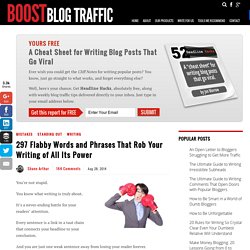
You know what writing is truly about. It’s a never-ending battle for your readers’ attention. Every sentence is a link in a taut chain that connects your headline to your conclusion. And you are just one weak sentence away from losing your reader forever. So you take your craft quite seriously. You ignore all but your best ideas. You work on each piece of writing for exactly as long as necessary to get it right. And you edit until your words are crisp and clear. But what if that isn’t enough? What if weaknesses remain that are almost impossible to spot? The Subtle Attention Killers That Hide in Plain Sight.
Some common nominalizations. Home, Nominalization, Revising Sentences, Index Some examples of nominalizations In the following examples, nouns that should be verbs are red; transitive active versions of the nouns are blue; and transitive passive versions of the nouns are green. destabilization Ecosystem destabilization can be the consequence of invasion.
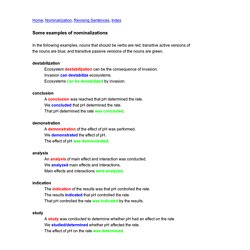
10 Tips on How to Write Less Badly - Do Your Job Better. By Michael C.
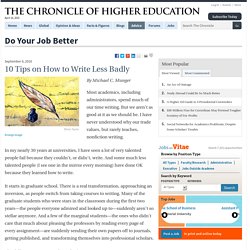
Munger Most academics, including administrators, spend much of our time writing. But we aren't as good at it as we should be. I have never understood why our trade values, but rarely teaches, nonfiction writing. In my nearly 30 years at universities, I have seen a lot of very talented people fail because they couldn't, or didn't, write. It starts in graduate school. The difference is not complicated. Rachel Toor and other writers on these pages have talked about how hard it is to write well, and of course that's true. The%20Scholarly%20Paper.pdf. What is a Scholarly Source? When I use the term "scholarly source", I mean a source that is peer reviewed or published in a recognized scholarly source, like a journal or a university publisher.
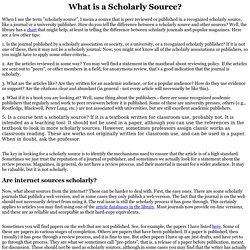
How do you tell the difference between a scholarly source and other sources? Well, the library has a chart that might help, at least in telling the difference between scholarly journals and popular magazines. Here are a few other tips: 12946_Manuscript_Tips.pdf. A Step-by-Step Guide on Writing a Scholarly Paper. Scholarly.pdf. Academic publishing. Academic publishing is the subfield of publishing which distributes academic research and scholarship.
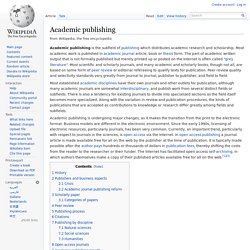
Most academic work is published in academic journal article, book or thesis form. The part of academic written output that is not formally published but merely printed up or posted on the Internet is often called "grey literature". Most scientific and scholarly journals, and many academic and scholarly books, though not all, are based on some form of peer review or editorial refereeing to qualify texts for publication. Peer review quality and selectivity standards vary greatly from journal to journal, publisher to publisher, and field to field. Most established academic disciplines have their own journals and other outlets for publication, although many academic journals are somewhat interdisciplinary, and publish work from several distinct fields or subfields.
History[edit] Publishers and business aspects[edit] Crisis[edit] Main article: Serials crisis Scholarly paper[edit] Citations[edit] What Is a Scholarly Source? Scholarly Writing. Guidelines for Writing Scholarly Papers. Guidelines for Writing Scholarly Papers Department of History and Political Science Ashland University Basic Structure Things to Avoid Things to Do Style Sheet for Student Papers Writing, even just a brief essay, is one of the most difficult tasks that you will face in college.
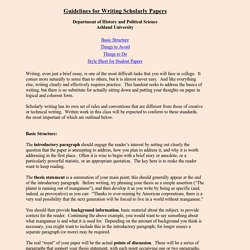
Scholarly writing has its own set of rules and conventions that are different from those of creative or technical writing. Basic Structure: The introductory paragraph should engage the reader’s interest by setting out clearly the question that the paper is attempting to address, how you plan to address it, and why it is worth addressing in the first place. The thesis statement is a summation of your main point; this should generally appear at the end of the introductory paragraph. You should then provide background information, basic material about the subject, to provide context for the reader. The real “meat” of your paper will be the actual points of discussion. Things to Avoid: Things to Do: Sources: WhatIsAScholarlyPaper.pdf. StyleWriter 4 - Professional Plain English Proofreading and Editing Software.